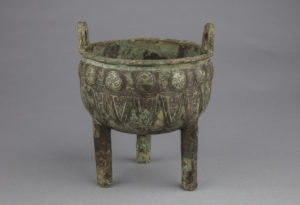The following dialogue is from an interview conducted with Museum Anthropology student Ariadne Argyros. In this interview, she discusses one of the projected themes within the greater exhibition–Gathering.

Why did you choose this object?
Originally I chose the ding vessel because it caught my eye. It’s a beautiful piece with a remarkably ornate design. The catalogue sheet also revealed its date (ca. 1300-1100 BCE) which was exciting for me because I love working with ancient artifacts.
What was a surprising and interesting fact about the ding vessel?
These vessels originated as plain cooking pots, hence the tripod shape. I was surprised and excited to learn that through the years the bowls grew in size and importance, eventually becoming significant symbols of power during the Shang Dynasty.
How does this object fit into the greater theme of gathering?
The ding vessel is an object of power that was meant to be seen by people outside the home. It is an artifact that legitimized emperors and became part of an ancient tradition of worship and ritual. These vessels were meant to be seen and used in communal activities, which is why the Fleming’s ding fits so well in the gathering area of the exhibit.
What brought you to the gathering category?
Originally the ding vessel was being considered for the preparing area because of its origins as a cooking vessel, and then it was going to be placed on the mantle. Neither of those places accurately represented the significance of the vessel and what it meant to the people of ancient China, so our group thought it would be more appropriate if it were placed in the gathering section next to other power objects so its importance would be more impactful.
We struggled with naming this area because it is a place where many different activities take place depending on when and where one is. We decided that this area displays objects of relaxation, socialization, and the worship of culturally and/or religiously significant objects. In the end, the inclusive word ‘gathering’ made the most sense.
What is your vision for this section, and how would you like to portray this to the public?
I hope that people will look at the section and see a grouping of objects that come together to showcase a non-Western specific area of gathering, which encompasses comfort, socialization, and appreciation of sacred, but not necessarily religious, objects. I hope that museum-goers will see all of this and come out questioning their own preconceived notions of a gathering space, as well leave with a new appreciation of other cultures and how they create(d) home.
How are you attempting to make gathering a relatable group for visitors while still encompassing a wide breadth of cultures?
Our group has strived to include a layout and a spread objects that are familiar, but with a twist to make visitors think about what home means to different people. We have explanatory labels, a color scheme and layout that is meant to set the scene, and some interactive, educational tools to encourage exploration and discussion. The concept of home is familiar to everyone in some way or another, so these objects collectively create the right mix of familiar and foreign to be both relatable and educational.
Is there anything else that you would like to share with the viewers?
All the activities that take place in the four areas are ones that are essential to the making of a home. Everyone has a place to cook, eat, sleep, and come together. Of course, not all of these activities always take place in a singular area or even inside, but home is not necessarily about a physical space. Many people live(d) in houses, but it’s about the actions and motivations of the inhabitants that evoke the feeling of home.
